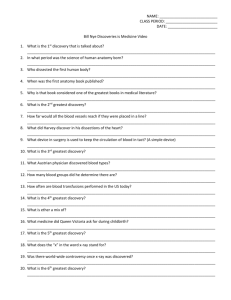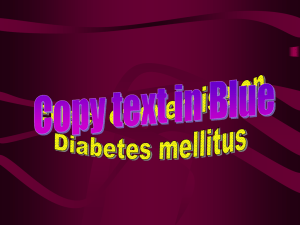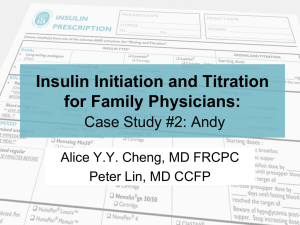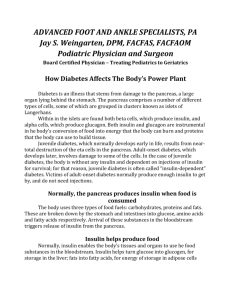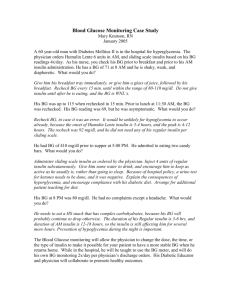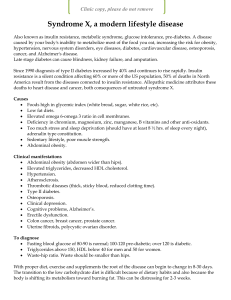Hunter Genetically Modified Insulin
advertisement
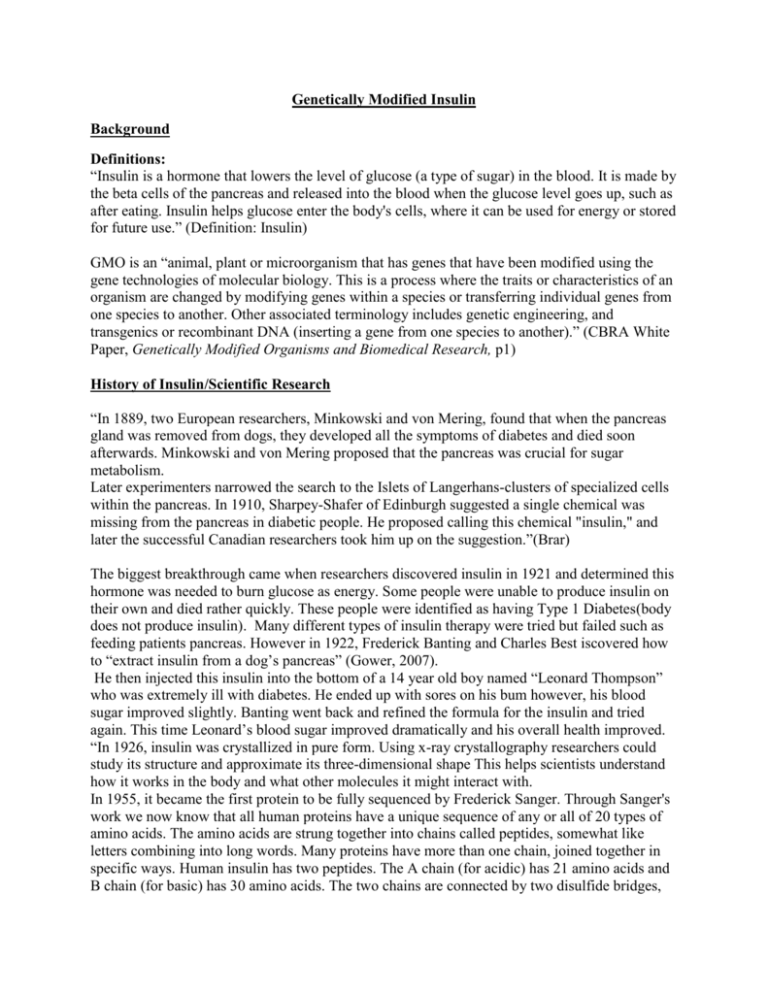
Genetically Modified Insulin Background Definitions: “Insulin is a hormone that lowers the level of glucose (a type of sugar) in the blood. It is made by the beta cells of the pancreas and released into the blood when the glucose level goes up, such as after eating. Insulin helps glucose enter the body's cells, where it can be used for energy or stored for future use.” (Definition: Insulin) GMO is an “animal, plant or microorganism that has genes that have been modified using the gene technologies of molecular biology. This is a process where the traits or characteristics of an organism are changed by modifying genes within a species or transferring individual genes from one species to another. Other associated terminology includes genetic engineering, and transgenics or recombinant DNA (inserting a gene from one species to another).” (CBRA White Paper, Genetically Modified Organisms and Biomedical Research, p1) History of Insulin/Scientific Research “In 1889, two European researchers, Minkowski and von Mering, found that when the pancreas gland was removed from dogs, they developed all the symptoms of diabetes and died soon afterwards. Minkowski and von Mering proposed that the pancreas was crucial for sugar metabolism. Later experimenters narrowed the search to the Islets of Langerhans-clusters of specialized cells within the pancreas. In 1910, Sharpey-Shafer of Edinburgh suggested a single chemical was missing from the pancreas in diabetic people. He proposed calling this chemical "insulin," and later the successful Canadian researchers took him up on the suggestion.”(Brar) The biggest breakthrough came when researchers discovered insulin in 1921 and determined this hormone was needed to burn glucose as energy. Some people were unable to produce insulin on their own and died rather quickly. These people were identified as having Type 1 Diabetes(body does not produce insulin). Many different types of insulin therapy were tried but failed such as feeding patients pancreas. However in 1922, Frederick Banting and Charles Best iscovered how to “extract insulin from a dog’s pancreas” (Gower, 2007). He then injected this insulin into the bottom of a 14 year old boy named “Leonard Thompson” who was extremely ill with diabetes. He ended up with sores on his bum however, his blood sugar improved slightly. Banting went back and refined the formula for the insulin and tried again. This time Leonard’s blood sugar improved dramatically and his overall health improved. “In 1926, insulin was crystallized in pure form. Using x-ray crystallography researchers could study its structure and approximate its three-dimensional shape This helps scientists understand how it works in the body and what other molecules it might interact with. In 1955, it became the first protein to be fully sequenced by Frederick Sanger. Through Sanger's work we now know that all human proteins have a unique sequence of any or all of 20 types of amino acids. The amino acids are strung together into chains called peptides, somewhat like letters combining into long words. Many proteins have more than one chain, joined together in specific ways. Human insulin has two peptides. The A chain (for acidic) has 21 amino acids and B chain (for basic) has 30 amino acids. The two chains are connected by two disulfide bridges, bonds formed between the sulfur atoms in the amino acid cystine. The A chain also has a third internal disulfide bridge. The disulfide bridges hold the molecule together. Without them, the protein would probably not be active in the body. ”Once a protein's sequence is known, it is possible, in theory, to recreate it synthetically. In fact, insulin was the first protein to be chemically synthesized in a laboratory, in 1963. But researchers were unable to produce much of it.” It wasn’t until 1978 that the biotechnology company Genetech was able to synthesize human insulin in large quantities. (Brar) Modern practice is to create insulin synthetically using genetically modified bacteria. “The team inserted the gene for human insulin into bacterial DNA, and used the bacteria as miniature factories to make the A and B chains of the protein separately. In a second step, a chemical process combined them. The result was human insulin, without the problems animal insulin sometimes causes. Humulin, as the commercial product was called, revolutionized diabetes treatment when it became widely available in the early 1980s. Today, almost all diabetic people use recombinant human insulin instead of animal insulin. In 1996 the Food and Drug Administration approved a modified form of human insulin called Humalog, which was specially developed to be active very quickly after injection.” (Gower, 2007) Genetic engineering to produce human insulin (Making human insulin) “Genetically-engineered bacteria are grown in large stainless steel fermentation vessels containing the nutrients needed for growth. Once fermentation is complete, the mixture containing the bacteria is harvested. The bacteria are broken open to release the insulin they have produced then it is purified and packed into bottles. Everything is sterile so there is no contamination. Regulations ensure insulin meets quality standards.” (Making human insulin), Advantages/Disadvantages Original Insulin taken from the pancreas of a pig or cow is limited in supply. It did not suit every one and caused severe rashes in some people. Vegetarians had ethical concerns with regards to this form of insulin Genetically Modified Insulin produced synthetically can be produced in higher quantities, produced in a clean, controlled environment, production costs are lower, less likely to have allergic or adverse reactions as it is identical to human insulin and is ethically acceptable as animals are not being sacrificed to create it. The Society for Diabetic Rights states that “a significant number of diabetics have experienced bad reactions to GMO insulin, and that some of these have resulted in death. Although GMO insulin poses a risk to some consumers of insulin, its comparatively greater availability and lower cost of production have prompted insulin manufacturers such as Eli Lilly to limit or disband production of pork or beef insulin. Diabetics who are unable to use GMO insulin find animal insulin more difficult to acquire. The Mayo Clinic website notes that a lack of insulin, which could result from this scarcity, exposes diabetics to additional problems, which include blindness, nerve damage and kidney damage.” (Callahan, 2013) There are other cases where people defend the use of animal insulin rather than the genetically modified human insulin. People provide testimonials that the human insulin has caused side effects such as; Crohns, fibromyalgia, weight gain, extreme fatigue, memory loss, depression, night sweats and insomnia. “There are many other reported negative effects from GM insulin. The most common being loss of hypoglycaemic warnings, leading to coma and death in some cases. These important hypo warnings, which are a natural bodily signal that blood glucose levels have dropped too low, often re-appear when a diabetic starts using animal insulin.” (Hirst, 2006) Chile, US and Canada are hosting safflower trials. They are using the safflower to produce a new genetically modified insulin which is cheaper to produce. However, there are concerns over the safety of the use of plants. How is the plant affected with pollution or crop contamination? Do these issues have effects on humans who consume them? Are there long term effects? (Levinson, 2007) With technological advancements and research, I believe the way we produce insulin will continually change and evolve. Diabetes is on the rise so research must continue to find a cure. I think even though there are side effects, the benefits outweigh the risks. Previous to these breakthroughs, diabetics were dying. According to Goldstein and Thomas (2004), “virtually every pharmaceutical product currently on the market can cause allergic reactions in some people.” The FDA approved the drugs because their benefits outweighed their allergenic potential. This will be the same approach taken on plant-made pharmaceuticals; the FDA will be concerned if, and only if, the plant-made pharmaceuticals are more allergenic than pharmaceuticals not derived from plants (Rogers 2003). Works Cited Brar, Deepinder. "The History of Isulin." ITR - Online. N.p., n.d. Web. 11 May 2014. <http://www.med.uni-giessen.de/itr/history/inshist.html>. Callahan, Rob. "The Pros & Cons of the Use of GMO Insulin." LIVESTRONG.COM. N.p., 24 Oct. 2013. Web. 11 May 2014. <http://www.livestrong.com/article/231364-the-proscons-of-the-use-of-gmo-insulin/>. "Definition: Insulin." KidsHealth - the Web's most visited site about children's health. The Nemours Foundation, n.d. Web. 11 May 2014. <http://kidshealth.org/parent/diabetes_center/words_know/insulin.html>. Goldstein, D.A., Thomas, J.A. 2004. Biopharmaceuticals derived from genetically modified plants. QJM: An International Journal of Medicine 97:705-716. Gower, Timothy. "History of Insulin." HowStuffWorks. N.p., 9 Mar. 2007. Web. 11 May 2014. <http://health.howstuffworks.com/medicine/medication/history-of-insulin.htm>. Hirst, Jenny. "April 2006 Newsletter." Insulin Dependent Diabetes Trust. N.p., n.d. Web. 11 May 2014. <http://www.iddt.org/wp-content/uploads/2009/10/IDDT-Newsletter-April2006.pdf>. Levinson, Hugh. "Firm in GM insulin breakthrough." BBC News. BBC, 4 Apr. 2007. Web. 11 May 2014. <http://news.bbc.co.uk/2/hi/health/6518787.stm>. "Making human insulin." ABPI - Resources for Schools. N.p., n.d. Web. 11 May 2014. <http://www.abpischools.org.uk/page/modules/diabetes/diabetes6.cfm?coSiteNavigation _allTopic=1>. Rogers, K.K. 2003. The Potential of Plant-Made Pharmaceuticals. http://www.plantpharma.org/ials/index.php?id=1
